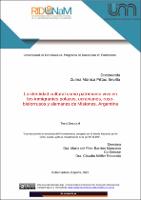La identidad cultural como patrimonio vivo en los inmigrantes polacos, ucranianos, ruso-bielorrusos y alemanes de Misiones, Argentina
Abstract
La presente investigación analiza los constructos culturales en relación con el
patrimonio vivo inmaterial de los grupos de inmigrantes polacos, ucranianos, rusosbielorrusos,
alemanes y sus descendientes, asentados en la provincia de Misiones
(Argentina) desde finales del siglo XIX. A partir de ellos, y con ellos, se seleccionaron las
expresiones culturales que cada grupo estudiado reconoce como representativas de su
identidad como colectivo social y que preservan hacia el interior de los mismos como legado
patrimonial, que, a la vez reactualizan y mantienen. Así mismo, se analizan los mecanismos
conductuales y estrategias adaptativas que desarrollan con el fin de mantener viva la
memoria a través de los distintos organismos, tanto informales como institucionalizados, que
los representan y que funcionan como garantes de la transmisión generacional. Este trabajo
aspira a visibilizar dos dimensiones superpuestas en relación con el sentimiento de identidad
de hijos y nietos de europeos y la pertenencia al estado-nación argentino, las formas de
convivencia entre ambas y las configuraciones simbólicas a través de las cuales se reconocen
a sí mismos, ofreciendo una manera novedosa de enfocar lo identitario: analizándolo desde
el sentido de lugar y desde el sentido de pertenencia, lo cual ayuda a pensar en nuevos
modelos y formas de convivencia que superen fórmulas que se han revelado, sobre todo en
Europa, ineficaces, tales como la adaptación, la inserción o la incorporación. The current research analizes cultural constructs related to the inmaterial living
heritage from polish, ukrainian, russian, german immigrants and their decendents, settled
in Misiones province (Argentina) from the end of the 19th century. From and with them, cultural expressions in each studied group that recognizes such expressions as representative of their own identity as a social collective preserving in them a patrimonial
legacy, and at the same time, are being updated and kept untill now, have been selected. In
addition, behavioural mechanisms and adaptive strategies developed with the purpose of
keeping memory alive through different organizations, formal or institutionalized, that
represent and function as guarantors of generational transmissions, have been analized.
This paper aims to visualize two superimposed dimensions related to the feeling of identity
from european children and grandchildren, as well as a sense of belonging to the
argentinian nation, forms of coexistance among them and symbolic configurations through
which they recognize themselves , offering a new way to focus the identitarian aspects :
considering from the sense of place and the sense of belonging that contribute to think in
new forms of coexistance that overcome revealing formulas, especially in Europe, as
inefficient as adaptation, insertion and integration.
Collections
- Doctorado [66]
The following license files are associated with this item:



